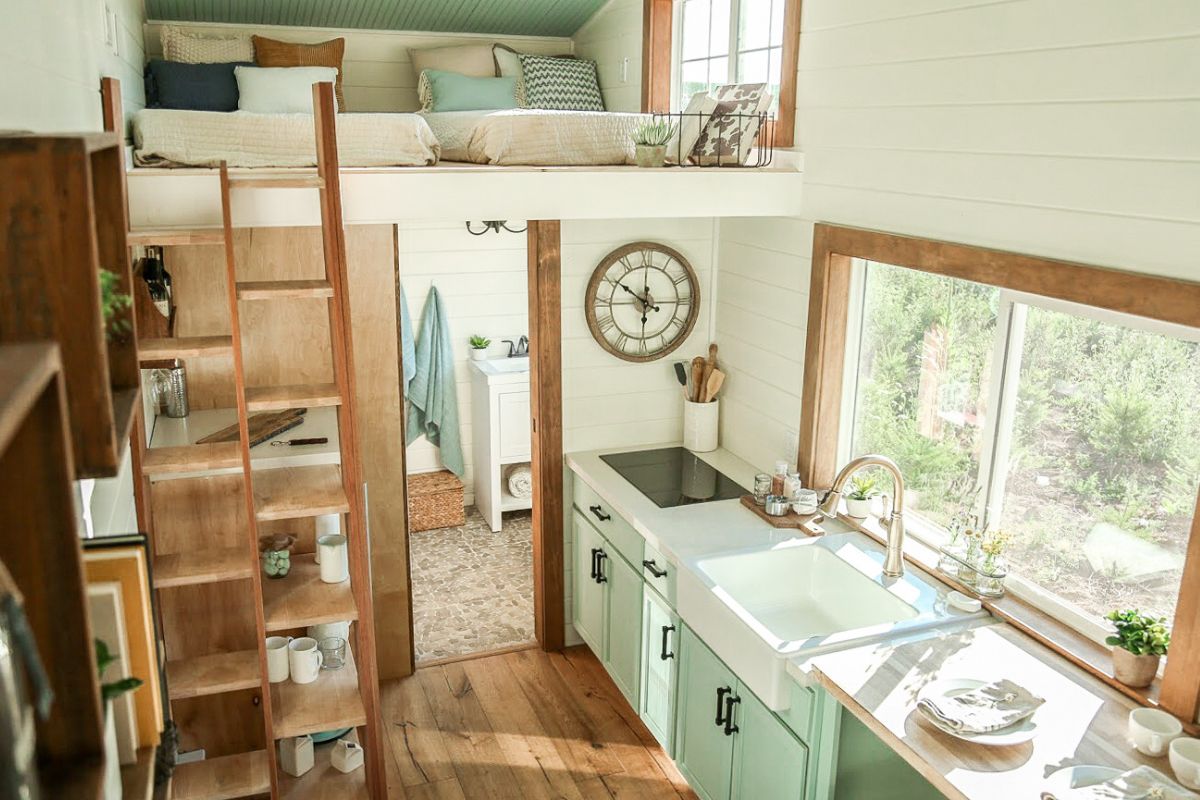Managing plumbing and electrical systems in a tiny house requires careful planning. Consider off-grid water options like rainwater collection, and embrace compact solutions such as wall-mounted fixtures and tankless water heaters.
Understand your power needs, create a detailed electrical layout, and choose the right wire gauge. Monthly maintenance checks, like inspections for leaks or circuit testing, are essential. Implement these strategies efficiently, and explore more to fully optimize your tiny living experience.
Key Takeaways
- Opt for tankless water heaters to conserve space and energy in tiny houses.
- Use compact plumbing solutions like wall-mounted toilets and corner showers to maximize space.
- Plan electrical wiring by determining power needs and choosing the correct wire gauge for safety.
- Regularly inspect plumbing connections and clean drains to prevent leaks and clogs.
- Ensure electrical systems are grounded properly and label breakers for easy identification.
Choosing the Right Plumbing System for Your Tiny House
Selecting the right plumbing system for your tiny house is essential to guarantee functionality and comfort. Start by evaluating your water source—whether it's connected to a grid or relies on a tank. For off-grid options, consider rainwater collection systems and filtration. You'll need a compact yet efficient water heater; tankless models save space and energy.
Choose between a traditional or composting toilet, depending on your waste management preferences and space constraints. For drainage, make certain pipes are insulated to prevent freezing in colder climates. Opt for flexible PEX tubing for easier installation and durability. Plan your layout efficiently, minimizing long pipe runs to conserve water pressure and heat. Prioritize accessibility for maintenance to keep your system running smoothly.
Exploring Compact Bathroom Solutions
When designing a tiny house, maximizing every inch of your bathroom space is essential. Start by considering a compact, all-in-one toilet and sink unit to save space. Wall-mounted toilets can also free up floor area, creating a more open feel. Install a corner shower to utilize often-overlooked space efficiently. Consider sliding doors instead of traditional swinging ones to avoid space interference.

Opt for multi-functional storage solutions like mirrored cabinets or shelves above the toilet for towels and toiletries. Use light colors and mirrors to enhance the sense of space and brightness. Think vertical—install hooks and racks to keep items off the floor. With careful planning, you'll create a functional, comfortable bathroom that fits perfectly in your tiny home.
Efficient Water Heating Options
Creating an efficient bathroom layout is just one piece of the puzzle when living in a tiny house. Choosing the right water heating option is essential for space and energy savings. Tankless water heaters are a popular choice; they heat water on demand, saving space and reducing energy consumption. If you prefer something off-grid, consider a solar water heater.
It's eco-friendly and utilizes free solar energy, though it might need a backup in cloudy weather. Propane water heaters are another compact alternative, ideal for areas with limited electricity. They're efficient and heat water quickly. Evaluate your water heating needs, considering factors like climate and available energy sources, to make an informed decision that complements your tiny house lifestyle.

Planning and Installing Electrical Wiring
Before you start the installation, it's crucial to plan your tiny house's electrical wiring carefully. Begin by determining your power needs, considering lighting, outlets, and major appliances. Create a detailed floor plan, marking locations for outlets, switches, and fixtures. Verify your design meets local building codes and safety standards.
Next, choose the right wire gauge based on the circuit's amperage. For example, a 20-amp circuit typically requires 12-gauge wire. Install a breaker panel with enough spaces for future expansion. Run wires through walls, securing them with staples and avoiding sharp bends.
Properly ground your system to prevent electrical shocks. Connect circuits to the breaker panel, and test each one thoroughly. Finally, label breakers for easy identification.
Selecting Energy-Efficient Appliances
While planning your tiny house, prioritize selecting energy-efficient appliances to optimize space and energy use. Begin with compact, multipurpose devices that save space and reduce electricity consumption. Look for Energy Star-rated appliances, which are designed to use less energy without sacrificing performance. Focus on essentials like a high-efficiency mini fridge, induction cooktop, and combination washer-dryer unit.
Consider the size and capacity of each appliance, ensuring they fit your living needs without excessive energy demands. Opt for LED lighting, which uses less power and lasts longer than traditional bulbs. Additionally, choose appliances with programmable settings, allowing you to tailor usage and minimize waste. By selecting energy-efficient options, you reduce environmental impact and potentially lower utility costs, creating a sustainable and cost-effective tiny home.
Solar Power Solutions for Tiny Homes
How can you power a tiny home sustainably? Solar power is an excellent solution. Start by evaluating your energy needs to determine the size of the system you require. A typical tiny home might need a 1-3 kW system. Choose between roof-mounted solar panels or ground-mounted systems if space allows. Confirm your home is positioned to maximize sun exposure.

You'll also need a battery bank to store excess energy for cloudy days or nighttime. Lithium-ion batteries are efficient and long-lasting. Don't forget an inverter to convert solar energy into usable electricity. Portable solar generators can offer flexibility, especially if you move frequently. With proper planning, solar power can meet your energy needs efficiently, reducing dependence on traditional power sources.
Tips for Regular Maintenance and Troubleshooting
Maintaining your tiny home's plumbing and electrical systems efficiently requires regular checks and prompt troubleshooting. Inspect plumbing connections monthly for leaks or corrosion, and guarantee pipes are well-insulated against temperature changes. Clean drains regularly to prevent clogs.
Check your water heater's pressure valve and inspect for leaks or rust. For electrical systems, verify circuit breakers are functioning correctly and test GFCI outlets monthly. Keep an eye on wiring for any signs of wear or overheating. Replace bulbs with energy-efficient options and guarantee all appliances are in good working order. If you notice flickering lights or unusual noises from appliances, address these issues immediately. By staying proactive, you'll minimize disruptions and extend the life of your home's essential systems.
Conclusion
Managing plumbing and electrical systems in your tiny house efficiently requires careful planning and smart choices. By selecting compact bathroom solutions, energy-efficient appliances, and exploring solar power options, you can maximize space and minimize costs. Guarantee proper installation of electrical wiring and choose efficient water heating methods to enhance sustainability. Regular maintenance and troubleshooting are key to keeping everything running smoothly. With these strategies, you'll create a comfortable, eco-friendly living environment in your tiny home.






Share: